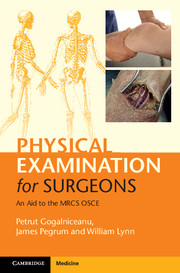Book contents
- Frontmatter
- Dedication
- Contents
- List of contributors
- Introduction
- Acknowledgments
- List of abbreviations
- Section 1 Principles of surgery
- Section 2 General surgery
- Section 3 Breast surgery
- Section 4 Pelvis and perineum
- 10 Examination of the anus
- 11 Examination of the pudendum and vagina
- 12 Examination of the penis
- 13 Examination of the scrotum
- Section 5 Orthopaedic surgery
- Section 6 Vascular surgery
- Section 7 Heart and thorax
- Section 8 Head and neck surgery
- Section 9 Neurosurgery
- Section 10 Plastic surgery
- Section 11 Surgical radiology
- Section 12 Airway, trauma and critical care
- Index
10 - Examination of the anus
from Section 4 - Pelvis and perineum
Published online by Cambridge University Press: 05 July 2015
- Frontmatter
- Dedication
- Contents
- List of contributors
- Introduction
- Acknowledgments
- List of abbreviations
- Section 1 Principles of surgery
- Section 2 General surgery
- Section 3 Breast surgery
- Section 4 Pelvis and perineum
- 10 Examination of the anus
- 11 Examination of the pudendum and vagina
- 12 Examination of the penis
- 13 Examination of the scrotum
- Section 5 Orthopaedic surgery
- Section 6 Vascular surgery
- Section 7 Heart and thorax
- Section 8 Head and neck surgery
- Section 9 Neurosurgery
- Section 10 Plastic surgery
- Section 11 Surgical radiology
- Section 12 Airway, trauma and critical care
- Index
Summary
Checklist
WIPER
• Chaperone and good light source
• Gloves and lubricating gel
• Patient on couch, left lateral position, knees up towards the chest
Physiological parameters
General
• Perineal excoriation or dermatitis
• Abnormal discharge at the anal verge: pus, blood, faeces
External
• Inspection of gluteal cleft: pilonidal disease (sinus or abscess)
• Inspection of perineum:
• erythema, abnormal moisture or purulent discharge
• haemorrhoids, abscesses, fissures, fistulas, skin tags
• scars or wounds from previous abscess drainage
• setons
• anorectal prolapse (ask patient to cough)
• Palpation:
• anal sphincter contour
• perianal sensation
•perianal fluctuance
Internal (digital rectal examination)
• Pain
• Anal sphincter tone
• Pelvic peritoneal irritation
• Pelvic abscess
• Masses in anus
• Prostate/uterine cervix (anteriorly)
• Areas of induration or fluctuance: fissures, haemorrhoids, fistulas
• Blood on examining finger
Special tests
• Faecal occult blood testing
• Proctoscopy
• Rigid sigmoidoscopy (10 – 20 cm)
To complete the examination…
• Examine groins for inguinal lymphadenopathy
Examination notes
Tips
Always have a chaperone in the room, irrespective of patient's or examiner's gender.
Have adequate lighting.
Stretch the anal skin with the fingers of the non-examining hand to reveal subtle lesions, such as anal fissures or sentinel tags.
Absence of blood on the examining finger does not exclude lower gastrointestinal bleeding. Microscopic bleeding can be identified with bedside occult bleeding testing kits.
What are the basic history points that need to be established?
• Pain
• Prolapse
• Pruritus
• Incontinence
• Abnormal discharge: pus, mucus, blood
• Anal trauma or intercourse
• Past medical history of Crohn's disease
Mnemonic for findings on external inspection of the anus: HAFFSSSHaemorrhoids, Abscesses, Fissures, Fistulas, Skin tags, Scars, Setons
What is Goodsall's rule?
• With the patient in the lithotomy position, an imaginary transverse line is drawn horizontally (from 9 to 3 o'clock) to bisect the anus – the transverse anal line.
- Type
- Chapter
- Information
- Physical Examination for SurgeonsAn Aid to the MRCS OSCE, pp. 99 - 101Publisher: Cambridge University PressPrint publication year: 2015

